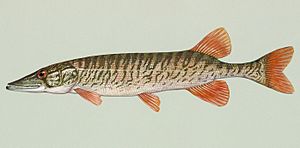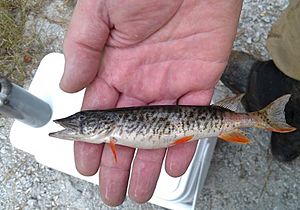Redfin pickerel facts for kids
Quick facts for kids Redfin pickerel |
|
|---|---|
 |
|
| Redfin pickerel, E. americanus americanus | |
| Conservation status | |
| Scientific classification |
|
| Kingdom: | Animalia |
| Phylum: | Chordata |
| Class: | Actinopterygii |
| Order: | Esociformes |
| Family: | Esocidae |
| Genus: | Esox |
| Species: | |
| Subspecies: |
E. a. americanus
|
| Trinomial name | |
| Esox americanus americanus J. F. Gmelin, 1789
|
|
The redfin pickerel (Esox americanus americanus) is a type of fish that lives in fresh water. It belongs to the pike family. This fish is special because it has bright red fins. Don't confuse it with its cousins, the grass pickerel or the chain pickerel.
Like all pikes, the redfin pickerel is a clever hunter. It waits quietly among thick vegetation (plants) for smaller animals to swim close. Then, it quickly attacks its prey.
Contents
Where Redfin Pickerel Live
You can find redfin pickerel in fresh water like lakes, streams, and swamps. They live along the Atlantic coast of North America. Their groups are found from Massachusetts down to Florida's Okeechobee Lake. They also live west into rivers that flow into the Gulf of Mexico, as far as Mississippi's Pascagoula River.
Because they are ambush hunters, redfin pickerel like clear water. They prefer places with lots of plants or decaying organic matter. These spots help them hide and wait for their next meal.
How Redfin Pickerel Are Built
The redfin pickerel is built perfectly for quick attacks. Its body shape helps it sprint fast. The dorsal fin (top fin) and anal fin (bottom fin) are located far back on its body. This helps the fish push through the water quickly.
Its side fins are small, which makes the fish more streamlined. The tail fin is quite large. This large tail gives the fish a lot of thrust (pushing power) to move fast. Its body is shaped like a tube, its nose is flat, and its head is smooth. All these features help it glide through water easily.
Redfin pickerel use their sight a lot to find food. They have large eyes and prefer clear, shallow water. Their scales are usually green or brown on the sides. Their belly is white or light amber. Dark green stripes run down their sides. This coloring helps the pickerel camouflage (blend in) with plants while hunting.
The fish's mouth is at the front of its snout. It has many long, cone-shaped teeth. These teeth are great for catching fast-moving prey. Unlike larger pikes, the redfin pickerel usually grows to about twelve inches long.
Redfin Pickerel Life Cycle
Redfin pickerel usually lay eggs in the spring. This happens from late February to early May. Fish in warmer waters breed earlier than those in colder areas. To breed, these fish leave their usual rivers and lakes. They meet in small streams where the water is cool.
One female fish will scatter her eggs among the plants. Then, several male fish will release their milt (sperm) into the water around the eggs. The parent fish leave the area soon after. The young fish are left to take care of themselves.
The eggs hatch in about 12 to 14 days. The baby pickerel, called larvae, will swim together in groups. This helps them stay safe. After about two years, they become adults and can have their own babies. Then, they start living alone. Redfin pickerel usually live for five years. Some have been known to live for eight years.
What Redfin Pickerel Eat
The redfin pickerel is an ambush hunter. It waits quietly for animals to come close enough to strike. In its small, shallow water home, the pickerel is a top predator. It eats smaller fish, crayfish, and insect larvae.
When they are newly hatched, the tiny pickerel larvae eat other fish larvae and insects.
Protecting Redfin Pickerel
The redfin pickerel is currently listed as a species of "least concern" by the IUCN. This means it's not in immediate danger of disappearing. However, it still faces threats from environmental degradation (harm to the environment).
One big threat is habitat loss. This happens when wetlands are drained or dams are built. These actions can dry up streams where the fish live. Scientists have also noticed a problem with metals building up in the fish's body. This is called biomagnification.
Since the redfin pickerel is a top predator, it faces the greatest danger from toxins. When it eats smaller fish or other animals that have harmful substances in them, these chemicals build up in the pickerel's body. For example, mercury can build up. If a bird or human then eats the pickerel, they could be at risk of mercury poisoning.




